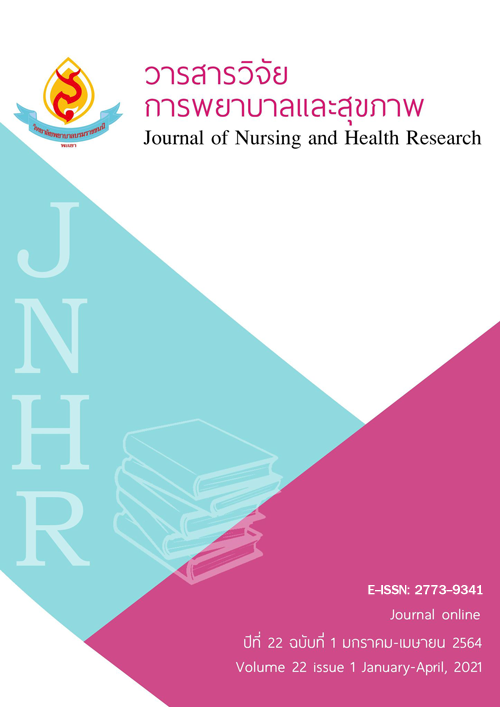ความชุกและปัจจัยที่มีความสัมพันธ์กับประสบการณ์การมีเพศสัมพันธ์ในเยาวชนที่กำลังศึกษาในระบบการศึกษาในเขตภาคเหนือ ประเทศไทย
คำสำคัญ:
ความชุก, ปัจจัย, ประสบการณ์การมีเพศสัมพันธ์, เยาวชนบทคัดย่อ
การมีเพศสัมพันธ์และปัญหาจากการมีเพศสัมพันธ์ที่ไม่ปลอดภัยของเยาวชน เป็นปัญหาสาธารณสุขที่สำคัญ โดยเฉพาะ การลดลงของการใช้ถุงยางอนามัยทุกครั้งที่มีเพศสัมพันธ์ ทำให้เกิดผลกระทบทางลบ เช่น การติดเชื้อ HIV การติดเชื้อโรคติดต่อทางเพศสัมพันธ์ และการตั้งครรภ์โดยไม่ตั้งใจตามมา การศึกษานี้ มีวัตถุประสงค์เพื่อศึกษาความชุกและปัจจัยที่สัมพันธ์กับประสบการณ์มีเพศสัมพันธ์ในเยาวชนที่อยู่ในระบบการศึกษาในเขตภาคเหนือ ประเทศไทย โดยใช้วิธีการศึกษาภาคตัดขวางเชิงพรรณนาเพื่อหาความสัมพันธ์ กลุ่มตัวอย่างเป็นเยาวชนในระบบการศึกษาในภาคเหนือ จำนวน 305 คน ศึกษาในระดับมัธยมปลายมัธยมศึกษาตอนปลาย 99 คน, อาชีวศึกษา 102 คน และมหาวิทยาลัย 104 คน รวบรวมข้อมูลโดยใช้แบบสอบถามออนไลน์ และทำการวิเคราะห์ข้อมูลโดยใช้สถิติเชิงพรรณนาและการวิเคราะห์ถดถอยโลจิสติกส์ ผลการศึกษา พบความชุกของประสบการณ์มีเพศสัมพันธ์ ของกลุ่มตัวอย่างเท่ากับ 26.56% โดยพบว่ามีเพียง 40.7% เท่านั้นที่ใช้ถุงยางอนามัยทุกครั้งเมื่อมีเพศสัมพันธ์ เยาวชนที่เรียนในโรงเรียนมัธยมมีประสบการณ์ทางเพศต่ำกว่าเยาวชนที่เรียนในโรงเรียนอาชีวศึกษาและมหาวิทยาลัย (p <.05) โดยผู้ที่อาศัยอยู่ร่วมกับแฟนมีประสบการณ์ทางเพศสูงกว่าคนที่อาศัยอยู่คนเดียวอาศัยอยู่กับพ่อแม่ญาติหรือเพื่อน (p <.01) อย่างไรก็ตามนักเรียนที่มีประสบการณ์ทางเพศรับรู้ว่ามีความเสี่ยงต่อการติดเชื้อเอชไอวีและการตั้งครรภ์โดยไม่ตั้งใจสูงกว่าผู้ที่ไม่เคยมีเพศสัมพันธ์มาก่อน (p <.05) ผลการศึกษาครั้งนี้แสดงให้เห็นแนวโน้มที่ลดลงของความชุกในประสบการณ์มีเพศสัมพันธ์และการใช้ถุงยางอนามัยที่เพิ่มขึ้นในเยาวชนในภาคเหนือของประเทศไทย ซึ่งอาจเป็นผลจากการใช้โปรแกรมการสอนเพศศึกษาแบบครอบคลุมที่ผ่านมา แต่อย่างไรก็ตามผลกระทบทางลบจากการมีเพศสัมพันธ์ที่ไม่ปลอดภัยยังคงมีอยู่ ดังนั้นควรมีการพัฒนาระบบบริการสุขภาพทางเพศที่เป็นมิตรกับเยาวชนที่ตอบสนองกับความต้องการและเข้าถึงได้มากขึ้น
เอกสารอ้างอิง
เมธิกา ศรีสด และพิมลพรรณ อิศรภักดี. (2559). การยอมรับพฤติกรรมการมีเพศสัมพันธ์ก่อนแต่งงานของคนไทย. วารสารวิจัยราชภัฏพระนคร สาขามนุษยศาสตร์และสังคมศาสตร์, 11(2), 137-145.
รวมพร คงกําเนิด, ศิริอร สินธุ และชิตธนัช ทองคง. (2555). การรับรู้ความรุนแรงและการรับรู้โอกาสเสี่ยงของการ ติดเชื้อทางเพศสัมพันธ์ในวัยรุ่นผู้หญิงไทย. วารสารพยาบาลศาสตร์, 30(1), 61-69.
สมดี อนันต์ปฏิเวธ, สุหรี หนุ่งอาหลี และปรียะดา ภัทรสัจจธรรม. (2561). วัยรุ่นตั้งครรภ์ไม่พร้อม: ผลกระทบ แนวโน้มและการช่วยเหลือในสังคมโลกไร้พรมแดน. วารสารการพยาบาลและการศึกษา. 11(1), 16-31.
Aurpibul, L., Tangmunkongvorakul, A., Musumari, P. M., Srithanaviboonchai, K., & Tarnkehard, S. (2016). Patterns of sexual behavior in lowland Thai youth and ethnic minorities attending high school in rural Chiang Mai, Thailand. PloS one, 11(12), e0165866.
Brüll, P., Kessels, L. T., Repetto, L., Dirkson, A., & Ruiter, R. A. (2019). ERPs reveal disengagement processes related to condom use embarrassment in intention-behavior inconsistent young adults. Archives of Sexual Behavior, 48(2), 521-532.
Drew, B. R. (2019). The Thai State and Sexual Health Policy: Deconstructing the culture of silence and stigrmatisation of young people's non-marital heterosexual activity (Doctoral dissertation).
Fongkaew, K. (2017). Media usage and consumption practice in shopping malls among female youth in modern Thai society. Mimbar: Journal Sosial dan Pembangunan, 33(2), 397-405.
Fongkaew, W., & Fongkaew, K. (2016). My space, my body, my sexual subjectivity: social media, sexual practice and parental control among teenage girls in urban Chiang Mai. Culture, Health & Sexuality, 18(5), 597-607.
Fuller, T. D., Chamratrithirong, A., & Apipornchaisakul, K. (2017). The correlates and gender differences of sexual behavior of single young adults in Thailand. Journal of Population and Social Studies, 25(4), 328-342.
Kalolo, A., & Kibusi, S. M. (2015). The influence of perceived behaviour control, attitude and empowerment on reported condom use and intention to use condoms among adolescents in rural Tanzania. Reproductive Health, 12(1),105.
Kancham, S., Rudtanasudjatum, K., Thetkhathuek, A., & Chaoniyom, W. (2018). Predictors of sexual risk prevention in heterosexual male adolescents. Journal of Health Science, 27(5), 800-808.
Musumari, P. M., Tangmunkongvorakul, A., Srithanaviboonchai, K., Manoyosa, V., Tarnkehard, S., Techasrivichien, T., . . . Chariyalertsak, S. (2017). Risky sexual behavior among out-of school Thai and non-Thai youth in urban Chiang Mai, Thailand. The Southeast Asian Journal of Tropical Medicine and Public Health, 48(1), 213-226.
Newman, P. A., Tepjan, S., & Rubincam, C. (2017). Exploring sex, HIV and ‘sensitive’ apace (s) among sexual and gender minority young adults in Thailand. In R. S. Barbour & D. L. Morgan (Eds.) A New Era in focus Group Research (pp. 83-106). London: Palgrave Macmillan.
Pinyaphong, J., Srithanaviboonchai, K., Musumari, P. M., Tangmunkongvorakul, A., Chariyalertsak, S., & Phornphibul, P. (2018). Predictors of condom use among heterosexual male university students in northern thailand using a psychological factors model. Southeast Asian Journal of Tropical Medicine and Public Health, 49(3), 489-501.
Protogerou, C., Hagger, M. S., & Johnson, B. T. (2017). An integrated theory of condom use for young people in Sub-Saharan Africa: A meta-analysis. Retrieved 30 October, 2020, from https://doi.org/10.31222/osf.io/24gyk
Sirirassamee, T., Yoelao, D., Mohan, K. P., & Limkhunthummo, S. (2018). The relationships between sexual risk behaviors and general health risk behaviors among unmarried youth in Thailand. SAGE Open Medicine, 6, doi: 2050312118813284.
Srijaiwong, S., Sindhu, S., Ratinthorn, A., & Viwatwongkasem, C. (2017). Factors influencing sexual behaviors among Thai adolescents. Journal of Population and Social Studies, 25(3), 171-193.
Tan, S. A., Yaacob, S. N., & Tan, J. P. (2018). The usage of sexual internet media and sexual behaviour among sexually experienced adolescents in Malaysia: Sexual intention as a mediator. Pertanika Journal of Social Sciences and Humanities, 26(4), 2571-2582.
Teye‐Kwadjo, E., Kagee, A., & Swart, H. (2017). Predicting the intention to use condoms and actual condom use behaviour: A three‐wave longitudinal study in ghana. Applied Psychology: Health and Well‐Being, 9(1), 81-105.
Thianthai, C. (2019). Young people’s views of the constraints on sex education in Bangkok, Thailand. Sex Education, 19(2), 180-194.
Thongnopakun, S., Maharachpong, N., & Abdullakasim, P. (2016). Factors related to the sexual behaviors among youth in universities located in the eastern region of Thailand. Journal of the Medical Association of Thailand, 99(1), 43-50.
Viseskul, N., Fongkaew, W., Settheekul, S., & Grimes, R. M. (2015). Factors related to sexual self-efficacy among Thai youth living with HIV/AIDS. Journal of the International Association of Providers of AIDS Care (JIAPAC), 14(5), 423-427.
Wiwattanacheewin, K. (2014). Prevalence and Intention to Use HIV Counseling and Testing Service Among Thai Youth. (Doctoral thesis). Bangkok. Mahidol University.
Wiwattanacheewin, K., Sindhu, S., Teitelman, A., Maneesriwongul, W., & Viwatwongkasem, C. (2015). Predictors of intention to use HIV testing service among sexually Experienced youth in Thailand. AIDS Education and Prevention, 27(2), 139-152.
ดาวน์โหลด
เผยแพร่แล้ว
รูปแบบการอ้างอิง
ฉบับ
ประเภทบทความ
สัญญาอนุญาต
ลิขสิทธิ์ (c) 2021 วารสารวิจัยการพยาบาลและสุขภาพ

อนุญาตภายใต้เงื่อนไข Creative Commons Attribution-NonCommercial-NoDerivatives 4.0 International License.



